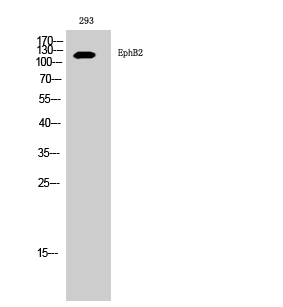EphB2 Polyclonal Antibody
- Catalog No.:YT1586
- Applications:WB;IHC;IF;ELISA
- Reactivity:Human;Mouse
- Target:
- EphB2
- Fields:
- >>Axon guidance
- Gene Name:
- EPHB2
- Protein Name:
- Ephrin type-B receptor 2
- Human Gene Id:
- 2048
- Human Swiss Prot No:
- P29323
- Mouse Swiss Prot No:
- P54763
- Immunogen:
- The antiserum was produced against synthesized peptide derived from human EPHB2. AA range:991-1040
- Specificity:
- EphB2 Polyclonal Antibody detects endogenous levels of EphB2 protein.
- Formulation:
- Liquid in PBS containing 50% glycerol, 0.5% BSA and 0.02% sodium azide.
- Source:
- Polyclonal, Rabbit,IgG
- Dilution:
- WB 1:500 - 1:2000. IHC 1:100 - 1:300. ELISA: 1:5000.. IF 1:50-200
- Purification:
- The antibody was affinity-purified from rabbit antiserum by affinity-chromatography using epitope-specific immunogen.
- Concentration:
- 1 mg/ml
- Storage Stability:
- -15°C to -25°C/1 year(Do not lower than -25°C)
- Other Name:
- EPHB2;DRT;EPHT3;EPTH3;ERK;HEK5;TYRO5;Ephrin type-B receptor 2;Developmentally-regulated Eph-related tyrosine kinase;ELK-related tyrosine kinase;EPH tyrosine kinase 3;EPH-like kinase 5;EK5;hEK5;Renal carcinoma antigen NY-REN-47
- Observed Band(KD):
- 117kD
- Background:
- This gene encodes a member of the Eph receptor family of receptor tyrosine kinase transmembrane glycoproteins. These receptors are composed of an N-terminal glycosylated ligand-binding domain, a transmembrane region and an intracellular kinase domain. They bind ligands called ephrins and are involved in diverse cellular processes including motility, division, and differentiation. A distinguishing characteristic of Eph-ephrin signaling is that both receptors and ligands are competent to transduce a signaling cascade, resulting in bidirectional signaling. This protein belongs to a subgroup of the Eph receptors called EphB. Proteins of this subgroup are distinguished from other members of the family by sequence homology and preferential binding affinity for membrane-bound ephrin-B ligands. Allelic variants are associated with prostate and brain cancer susceptibility. Alternative splicing results in multiple tr
- Function:
- catalytic activity:ATP + a [protein]-L-tyrosine = ADP + a [protein]-L-tyrosine phosphate.,disease:Defects in EPHB2 are involved in the development of prostate cancer metastasis to the brain [MIM:603688].,disease:Defects in EPHB2 are involved in the progression of prostate cancer [MIM:176807].,function:Receptor for members of the ephrin-B family. Acts as a tumor suppressor.,similarity:Belongs to the protein kinase superfamily. Tyr protein kinase family.,similarity:Belongs to the protein kinase superfamily. Tyr protein kinase family. Ephrin receptor subfamily.,similarity:Contains 1 protein kinase domain.,similarity:Contains 1 SAM (sterile alpha motif) domain.,similarity:Contains 2 fibronectin type-III domains.,subunit:The ligand-activated form interacts with multiple proteins, including GTPase-activating protein (RASGAP) through its SH2 domain. Binds RASGAP through the juxtamembrane tyrosi
- Subcellular Location:
- Cell membrane; Single-pass type I membrane protein. Cell projection, axon . Cell projection, dendrite .
- Expression:
- Brain, heart, lung, kidney, placenta, pancreas, liver and skeletal muscle. Preferentially expressed in fetal brain.
Comprehensive pan-cancer analysis reveals EPHB2 is a novel predictive biomarker for prognosis and immunotherapy response BMC CANCER Xu Shengshan IF Human 1:500 lung adenocarcinoma (LUAD) tissue
- June 19-2018
- WESTERN IMMUNOBLOTTING PROTOCOL
- June 19-2018
- IMMUNOHISTOCHEMISTRY-PARAFFIN PROTOCOL
- June 19-2018
- IMMUNOFLUORESCENCE PROTOCOL
- September 08-2020
- FLOW-CYTOMEYRT-PROTOCOL
- May 20-2022
- Cell-Based ELISA│解您多样本WB检测之困扰
- July 13-2018
- CELL-BASED-ELISA-PROTOCOL-FOR-ACETYL-PROTEIN
- July 13-2018
- CELL-BASED-ELISA-PROTOCOL-FOR-PHOSPHO-PROTEIN
- July 13-2018
- Antibody-FAQs
- Products Images

- Western Blot analysis of 293 cells using EphB2 Polyclonal Antibody diluted at 1:1000

- Western blot analysis of lysates from Jurkat cells, using EPHB2 Antibody. The lane on the right is blocked with the synthesized peptide.



